Category: A Formal System for Classification and Organization
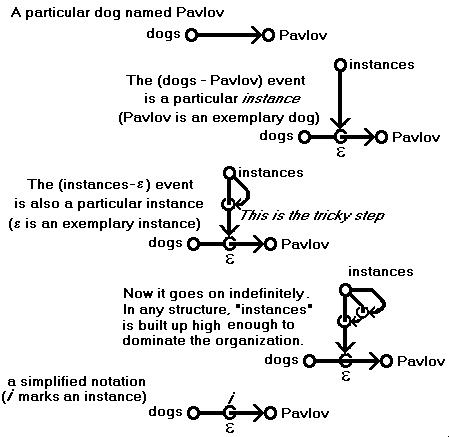 Instance relations organize data
structures. They are an
application of the relations
set forth in stage_3 of Water Trail
and implemented on device_2
of Ridge Route.
Instance relations organize data
structures. They are an
application of the relations
set forth in stage_3 of Water Trail
and implemented on device_2
of Ridge Route.
Co-ordinated activation of both a particular category
and the instances
relation will select the locations that belong to that
category. Commands can select locations
belonging to multiple categories in ways
that correspond to "and" and "or"
connectives of Boolean algebra.
The methods are practical. There is a
"tricky step" in the adjacent
diagram. The author finds it convincing;
but, even if you don't, you can still use
instance relations (including the trick)
to organize information in the examples:
1. representation of syntax
2. library research system
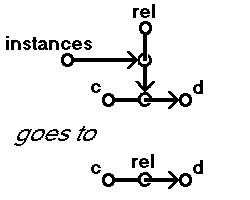 The simplified notation used for instances
can be generalized to notate other
relations. This generalized notation leads
to the introduction of generalized relations
discussed in connection with device_2.
The simplified notation used for instances
can be generalized to notate other
relations. This generalized notation leads
to the introduction of generalized relations
discussed in connection with device_2.
Representation of Syntax
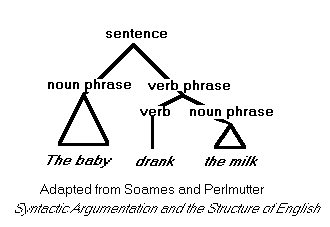 Structures of locations representing experience resemble
phrase structures used in linguistic theory to
represent language. Structures of locations
and phrase structures can interpret each other.
Structures of locations representing experience resemble
phrase structures used in linguistic theory to
represent language. Structures of locations
and phrase structures can interpret each other.
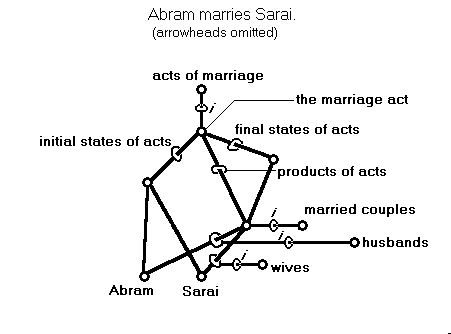 The act is a structure of locations
that can be interpreted as
a sentence. An act is a series of states connected
through identifications that establish objects
in experience interpretable as linguistic
subjects and objects. For example,
in the adjacent image,
a location in the initial state of the
act is identified with a location in
the final state and given the name
"Abram."
An act can also include
an action
schemata interpretable as a verb
and may involve
a doer (subject),
product, target or recipient (direct object) or
vehicle (indirect object).
The act is a structure of locations
that can be interpreted as
a sentence. An act is a series of states connected
through identifications that establish objects
in experience interpretable as linguistic
subjects and objects. For example,
in the adjacent image,
a location in the initial state of the
act is identified with a location in
the final state and given the name
"Abram."
An act can also include
an action
schemata interpretable as a verb
and may involve
a doer (subject),
product, target or recipient (direct object) or
vehicle (indirect object).
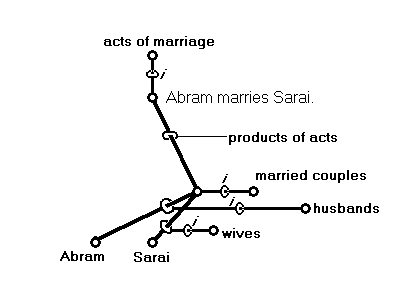 The structure notating the act can be
reduced to essentials (explicated).
The structure notating the act can be
reduced to essentials (explicated).
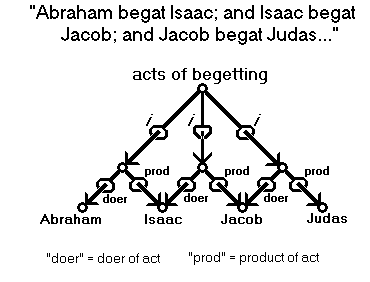 Several sentences can be represented
by an assembly of locational structures.
Conversely, an assembly of locational
structures can be disassembled into
units shaped by phrase structures.
Repeated words, pronouns and synonyms
indicate points of attachment for
assembly or cues for disassembly.
Several sentences can be represented
by an assembly of locational structures.
Conversely, an assembly of locational
structures can be disassembled into
units shaped by phrase structures.
Repeated words, pronouns and synonyms
indicate points of attachment for
assembly or cues for disassembly.
Library Research System
Several kinds of academic and professional literature follow
a common form, exemplified
by that used in the American legal system.
The legal system's central element is the case,
a decision of a court of appeal; cases are published in series of volumes
organized according to the court jurisdiction and
the date of issue of the decision.
In general, each decision is a bloc of text
that decomposes into blocs of text:
- a statement of
facts
- one or more statements of legal principles or
holdings
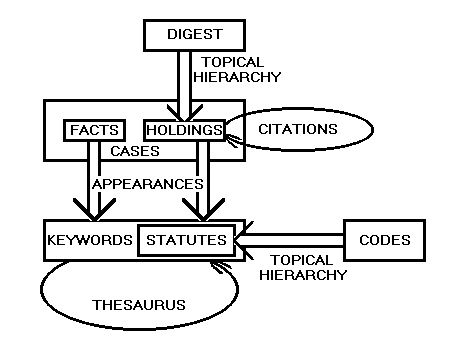 A holding may include one or more citations
to holdings in prior cases.
A holding may include one or more citations
to holdings in prior cases.
Legal publishers assign each holding
to one or more classes; and
the classes are organized in a digest
with a hierarchical structure of topics.
Words and phrases,
keywords,
appear in the blocs of text.
Some keywords,
like "California Civil Code §1649"
refer to statutes, rules of law enacted by
the legislature. Statutes are organized into codes,
compendia of statutes with their own hierarchical
structures of topics.
Although a thesaurus is not commonly
used in legal research, one could easily be constructed
and added to the system.

It is possible to conduct research with this system
through mass action techniques more powerful than the item-by-item
methods conventionally used. The system could be
installed on a conventional mainframe-sized computer,
although beyond the reach of personal computers presently
available.
For example, a researcher could begin with a set of
keywords (perhaps expanded with the thesaurus)
and obtain all holdings that include 3 or more of the keywords.
From the set of holdings so obtained, a new set could be
constructed based on citation clusters. Digest classes
obtained from the clusters could then be used to assemble
a set of "leading cases" obtained
through additional steps on the citation relations. Leading cases
could be ranked according to the number of times each is
cited in other cases derived from the digest classes. Possibly significant
statutes could also be identified and ranked according to
frequency of appearance.




All materials copyright by Robert Kovsky, 1997.
 The simplified notation used for instances
can be generalized to notate other
relations. This generalized notation leads
to the introduction of generalized relations
discussed in connection with device_2.
The simplified notation used for instances
can be generalized to notate other
relations. This generalized notation leads
to the introduction of generalized relations
discussed in connection with device_2.
 Instance relations organize data
structures. They are an
application of the relations
set forth in stage_3 of Water Trail
and implemented on device_2
of Ridge Route.
Instance relations organize data
structures. They are an
application of the relations
set forth in stage_3 of Water Trail
and implemented on device_2
of Ridge Route.
 Structures of locations representing experience resemble
phrase structures used in linguistic theory to
represent language. Structures of locations
and phrase structures can interpret each other.
Structures of locations representing experience resemble
phrase structures used in linguistic theory to
represent language. Structures of locations
and phrase structures can interpret each other.
 The act is a structure of locations
that can be interpreted as
a sentence. An act is a series of states connected
through identifications that establish objects
in experience interpretable as linguistic
subjects and objects. For example,
in the adjacent image,
a location in the initial state of the
act is identified with a location in
the final state and given the name
"Abram."
An act can also include
an action
schemata interpretable as a verb
and may involve
a doer (subject),
product, target or recipient (direct object) or
vehicle (indirect object).
The act is a structure of locations
that can be interpreted as
a sentence. An act is a series of states connected
through identifications that establish objects
in experience interpretable as linguistic
subjects and objects. For example,
in the adjacent image,
a location in the initial state of the
act is identified with a location in
the final state and given the name
"Abram."
An act can also include
an action
schemata interpretable as a verb
and may involve
a doer (subject),
product, target or recipient (direct object) or
vehicle (indirect object).
 The structure notating the act can be
reduced to essentials (explicated).
The structure notating the act can be
reduced to essentials (explicated).
 Several sentences can be represented
by an assembly of locational structures.
Conversely, an assembly of locational
structures can be disassembled into
units shaped by phrase structures.
Repeated words, pronouns and synonyms
indicate points of attachment for
assembly or cues for disassembly.
Several sentences can be represented
by an assembly of locational structures.
Conversely, an assembly of locational
structures can be disassembled into
units shaped by phrase structures.
Repeated words, pronouns and synonyms
indicate points of attachment for
assembly or cues for disassembly.
 A holding may include one or more citations
to holdings in prior cases.
A holding may include one or more citations
to holdings in prior cases.


